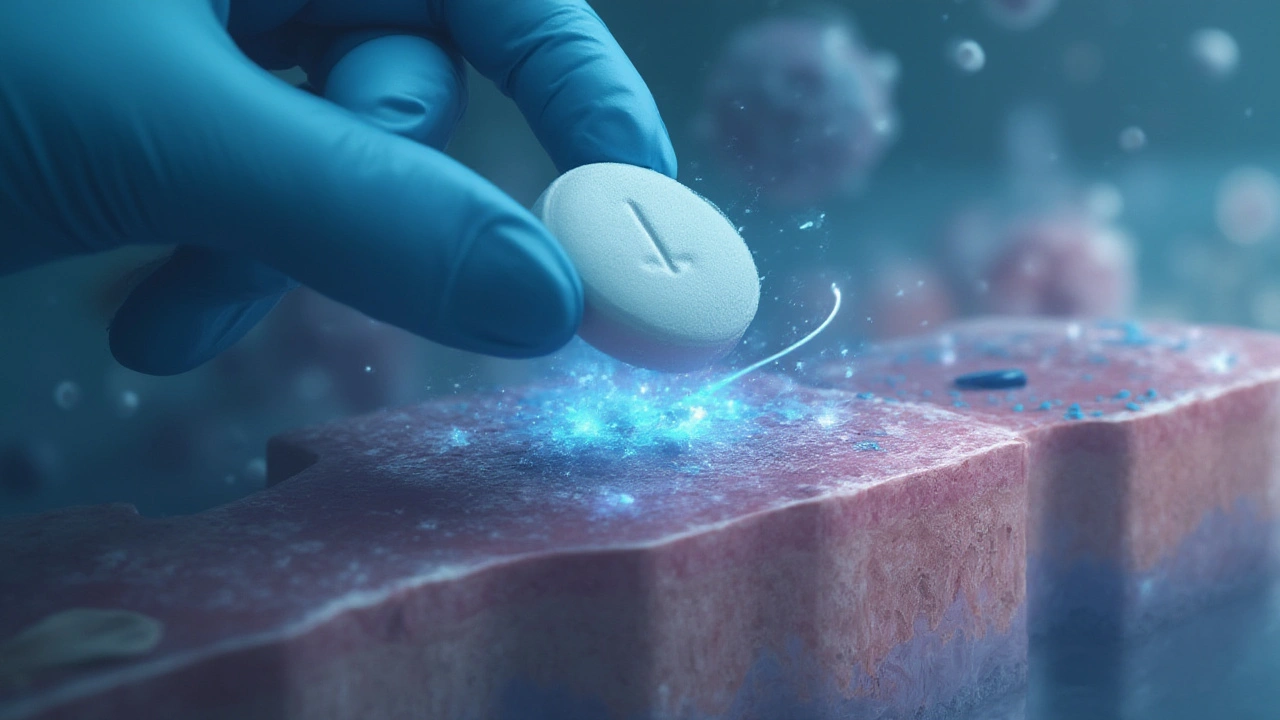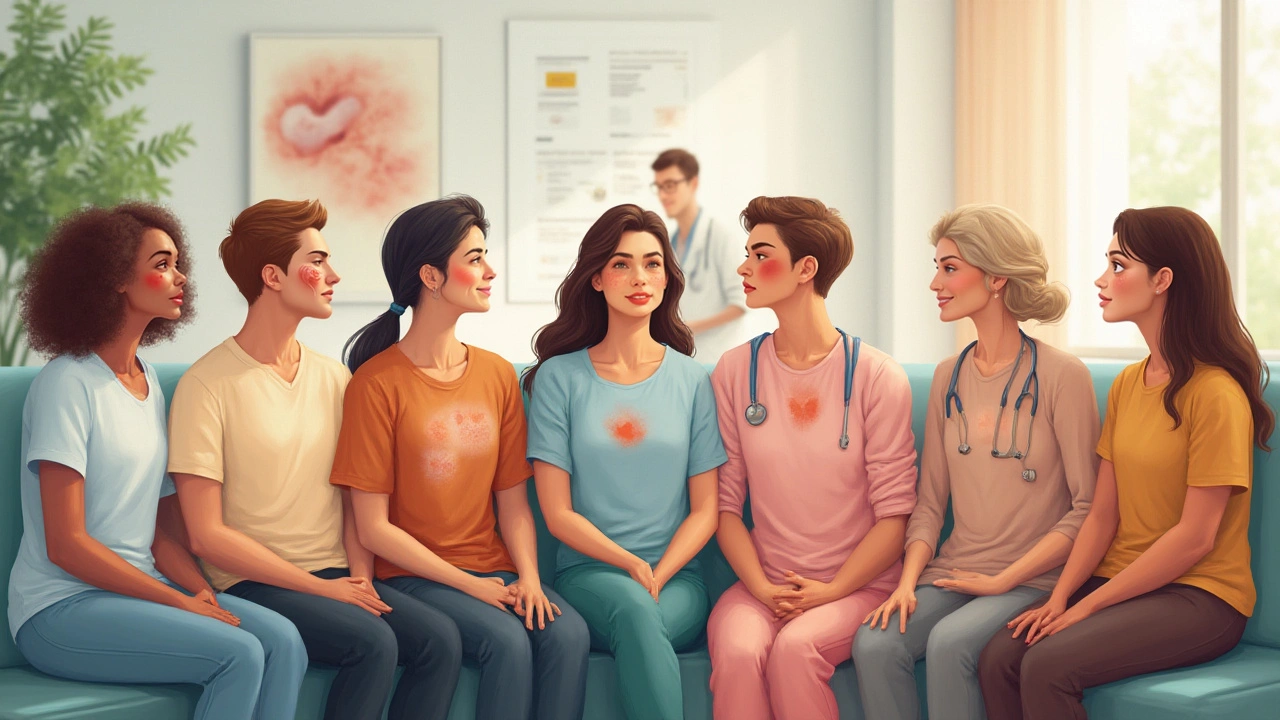Some treatments spark fierce debate, raising both hope and worry in equal measure—hydroxychloroquine is one of them. While it’s been a household name for reasons beyond dermatology, not enough people are clued in about how this medication really helps inflammatory skin issues. Isn’t it curious that a pill originally meant for malaria has such a big role in modern skin therapy? People with chronic conditions like lupus and dermatomyositis find themselves on it for years, sometimes decades. But what makes it worth the prescription?
Understanding Hydroxychloroquine: Where It All Began
Hydroxychloroquine (often called Plaquenil, its well-known brand) first walked onto the medicine stage back in the 1950s as a new way to prevent and treat malaria. What we don’t usually hear is how quickly doctors noticed some rare side effects—skin rashes subsiding, swollen joints easing up—especially among patients with strange autoimmune conditions. Fast forward a couple of decades, and dermatologists began prescribing it to help patients with skin symptoms from lupus, rheumatoid arthritis, and a wildcard of other stubborn inflammatory diseases.
The real magic of hydroxychloroquine lies in how it tweaks the immune system. It’s not a sledgehammer; it doesn’t just wipe out inflammation across the board. Instead, it whispers signals to the immune cells, telling them to calm down, dial back the crazy overreaction that makes skin sore, swollen, or discoloured. According to a 2022 review in the Journal of the American Academy of Dermatology, “hydroxychloroquine’s immune-modulating effect offers a uniquely tolerable balance of safety and efficacy in cutaneous lupus erythematosus.” Dermatologists in clinics from Bristol to Bristol, Tennessee, reach for it because the benefits can last for years, sometimes saving people from needing more toxic immunosuppressants or steroids.
What conditions is it most often used for? The headline act is lupus erythematosus (especially the cutaneous kind, which targets the skin), but it’s also prescribed for discoid lupus, dermatomyositis (a rare disease that both damages muscles and causes a distinct rash), and less often for lichen planus, sarcoidosis, or even chronic urticaria. Sometimes, doctors try it for stubborn eczema or sun sensitivity, especially when nothing else works.
Easy to take as a daily tablet, hydroxychloroquine is often part of a long-term routine. Most people notice improvements in their skin within two to three months, and for some, the change is honestly life-changing: less redness and swelling, less itching, and far fewer sores. One tip from dermatology nurses—always take your dose after a meal. Stomach upset is less likely that way, and it helps with absorption.
If you’re wondering about cost: in the UK, hydroxychloroquine is dirt cheap by modern standards—on the NHS, prescriptions often cost less than a good meal out. This makes it a favorite for healthcare systems with stretched budgets and patients who can’t afford the latest biologic wonder drug.
But what keeps dermatologists coming back to this old drug isn’t just the economics. It’s its track record for being safe, even for the long haul. So, what about the actual numbers? An estimated 70-80% of people with cutaneous lupus see their skin clear or substantially improve on hydroxychloroquine alone. Rarely, people with other skin diseases respond just as well. Have you heard about the famous study from 2019, run by dermatologists from the University of Leeds? They tracked 169 people with chronic discoid lupus—more than two thirds had at least 50% reduction in active skin lesions after six months on hydroxychloroquine.
As you’ll see, this medication isn’t perfect magic—but it’s got solid science behind it.
How Hydroxychloroquine Works On Skin: The Science Explained
It’s sort of wild—a malaria drug that tamps down skin inflammation. How? The answer is all about your immune system. In many skin diseases, your immune cells go off script, attacking healthy skin and causing rashes, swelling, blisters, and chronic itching or pain. Hydroxychloroquine targets those rogue immune pathways. Its unique trick? It sneaks into immune cells and tampers with how they sense danger, basically reprogramming your body’s response to triggers like sunlight or infection. The medication blocks certain proteins (called Toll-like receptors) and changes how cells handle acids inside themselves, which in turn stops them from spitting out inflammatory chemicals.
This is crucial, especially if you have conditions like cutaneous lupus, where sunlight can turn a day out into two weeks of miserable skin flares. A regular dose of hydroxychloroquine smoothes out those wild immune swings, helping skin repair itself.
Let’s look at what dermatologists actually see. Dr. Richard Warren, a leading dermatologist at Salford Royal NHS Foundation Trust, put it plainly:
“Hydroxychloroquine remains a cornerstone drug for many inflammatory skin diseases, enabling patients to not just treat flares but achieve real, long-term disease control.”
But the benefits aren’t just about ‘quieting’ skin problems. Hydroxychloroquine might also offer a shield against long-term complications of active lupus, including heart and kidney damage. There’s real-world evidence from Scandinavian lupus clinics: people taking hydroxychloroquine have a lower rate of severe flares, and their skin improves more predictably than folks who stop the drug.
Another fun fact—this medication is sometimes given in combo with other immune-calming meds. Plaquenil might be paired with methotrexate or corticosteroids for tough cases. The combo helps doctors use lower steroid doses, reducing those scary side effects like weight gain, brittle bones, and high blood pressure. It’s not just about fighting fires; it’s a way to manage the disease, day in and day out.
There are things you should know though: it’s a very slow-acting drug. For most people, results appear after about eight weeks, sometimes three months. Dermatologists get a bit nervous when patients demand instant results—this isn’t a quick fix. The key is patience and sticking with regular follow-up appointments.

Risks, Side Effects, and Long-term Safety: What’s the Reality?
Most doctors and patients love hydroxychloroquine for its safety rep, but every medication has its trade-offs. First, there’s the stomach grumbles—around 10% of users feel queasy or have mild diarrhea. Splitting the dose (half with breakfast, half with dinner) can actually help this. Some notice skin gets a bit darker or lighter in patches—it’s not dangerous but can be annoying, especially with long-term use.
The biggest worry is about eyes. A rare side effect, called retinopathy, can show up after years of treatment. It affects how you see colour and detail. The trick here is regular checks: the NHS recommends an eye test before starting and then at least yearly after five years on the drug. If doctors catch retinopathy early, it can almost always be stopped before it does real damage. Good news: the risk is much lower at standard doses (up to 400 mg daily), especially for folks with healthy kidneys and no eye disease. Most recent surveys in UK dermatology clinics report less than 1 in 1,000 patients get serious eye side effects.
There are a few more things to consider. Some people with psoriasis or porphyria may actually get worse on hydroxychloroquine—dermatologists always ask about these conditions before prescribing. Pregnant people (or those hoping to get pregnant) have extra questions, but real-world data shows hydroxychloroquine is among the safest drugs for managing lupus and similar diseases during pregnancy.
Avoid self-medicating or skipping regular blood tests: hydroxychloroquine affects the immune system, so your doctor will want to keep an eye on infection risk, rare allergic reactions, or headache. Most patients, though, do just fine for years on the same dose. Just don’t share pills with family members—drug reactions are impossible to predict person to person.
Here’s a practical takeaway: if you’re on hydroxychloroquine, stick to your routine, show up for eye checks, and tell your prescribing doctor about any new symptoms (think vision changes, muscle pain, or odd rashes). Try not to rely on online horror stories—most are outdated or rare exceptions.
Tips, Real Experiences, and What to Ask Your Doctor
The best advice usually comes from those who actually rely on this medication day in and day out. In lupus and dermatomyositis online support groups, you’ll spot people swapping little tricks: timing doses with dinner reduces nausea, and using sun protection during outdoor time helps keep rashes away. Even if you forget a single dose, don’t double up next time—just get back on track as soon as you remember.
If you want clear results, team up with your dermatologist. Show them photos of your worst skin flares; bring a diary jotting down what days you feel better or worse. This helps them figure out if hydroxychloroquine is working for you, especially those early months when it’s tough to notice slow changes.
Ask questions, especially at your annual review: Am I still on the right dose? Any news from my last eye check? Should I switch to another treatment if my rash suddenly gets worse? Having a routine check-in is vital—people who see their dermatology nurse or doctor on schedule almost always catch problems early and get better results.
If you’re new to hydroxychloroquine, talk about your other medicines with your doctor. Some drugs (including antacids, vitamin or mineral supplements) can affect how well it works, so your pharmacist should know about everything you take. And don’t forget—if you plan to travel, especially long trips to sunny places, pack extra sun cream and think about wearing a hat or long sleeves outdoors. UV light is a common trigger for many skin diseases treated by hydroxychloroquine.
Don’t be shy about seeking a second opinion if you’re not feeling better after six months, or if the side effects seem worse than the original problem. Dermatology is personal—what works for you might not work for your best mate or family member. Your own story matters most.
So, hydroxychloroquine may not be glamorous or new, but for lots of people with raging, stubborn skin issues, it opens the door to calmer days and brighter skin. Stick with your routine, keep in contact with your care team, and remember you’re not alone—thousands of people walk this path and find steady relief.

Alexander Levin
July 23, 2025 AT 19:17Ady Young
July 24, 2025 AT 08:36Travis Freeman
July 25, 2025 AT 10:41Sean Slevin
July 26, 2025 AT 22:06Chris Taylor
July 27, 2025 AT 23:22Melissa Michaels
July 28, 2025 AT 11:33Nathan Brown
July 29, 2025 AT 09:21Matthew Stanford
July 29, 2025 AT 16:32Olivia Currie
July 31, 2025 AT 12:17Curtis Ryan
July 31, 2025 AT 12:44Rajiv Vyas
August 1, 2025 AT 00:32farhiya jama
August 2, 2025 AT 05:22Astro Service
August 2, 2025 AT 23:59Ady Young
August 3, 2025 AT 21:48